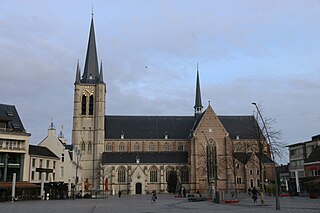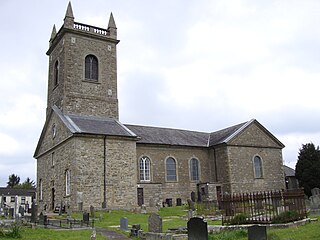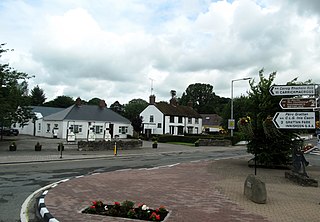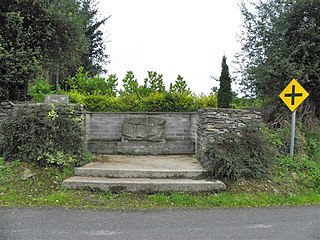
Geel is a city and municipality located in the Belgian province of Antwerp, which acquired city status in the 1980s. It comprises Central-Geel which is constituted of 4 old parishes a/o towns: Sint-Amand, Sint-Dimpna, Holven and Elsum. Further on around the center are the parish-towns of Ten Aard (N), Bel (E), Winkelomheide (SE), Stelen, Oosterlo and Zammel (S), Punt (SW) and Larum (W). In 2021, Geel had a total population of 40,781. The total area is 109.85 km2 (42 sq mi). Geel’s patron saint, the Irish Saint Dymphna, inspired the town’s pioneering de-institutionalized method of care for the mentally ill.

Dymphna is a Christian saint honoured in Catholic and Eastern Orthodox traditions. According to tradition, she lived in the 7th century and was martyred by her father.

Clones is a small town in the west of County Monaghan in Ireland. The area is part of the Border Region in the Republic of Ireland, earmarked for economic development by the Irish Government due to its currently below-average economic situation. The town was badly hit economically by the Partition of Ireland in 1921 because of its location on the border with County Fermanagh in Northern Ireland. The creation of the Irish border deprived it of access to a large part of its economic hinterland for many years. The town had a population of 1,680 at the 2016 census. The town is in a civil parish of the same name.

Clogher is a village and civil parish in the border area of south County Tyrone, Northern Ireland. It lies on the River Blackwater, 5.8 miles from the border crossing to County Monaghan. It stands on the townlands of Clogher Demesne and Clogher Tenements. The 2011 Census recorded a population of 717. The civil parish of Clogher covers areas of County Fermanagh as well as County Tyrone.
A townland is a small geographical division of land, historically and currently used in Ireland and in the Western Isles in Scotland, typically covering 100–500 acres (40–202 ha). The townland system is of Gaelic origin, antedating the Norman invasion, and most have names of Irish origin. However, some townland names and boundaries come from Norman manors, plantation divisions, or later creations of the Ordnance Survey. The total number of inhabited townlands in Ireland was 60,679 in 1911. The total number recognised by the Irish Place Names database as of 2014 was 61,098, including uninhabited townlands, mainly small islands.
Sheskin, traditionally divided into Sheskinmor and Sheskinbeg, is a townland in the north of County Monaghan in Ireland. It is in the foothills of Sliabh Beagh. Sheskin is part of the civil parish of Tydavnet, situated about 3 miles from the village of Scotstown and about 8 miles from Monaghan town. Sheskin is straddled in the east by the River Blackwater and in the south by one of its tributaries, which converge at the south eastern corner of the townland.

Scotstown is a village in the townland of Bough in north County Monaghan, Ireland. Scotstown is located in the parish of Tydavnet, along the Monaghan Blackwater, Scotstown being the village closest to the river's source. Scotstown is centred in the townland of Bough, but extends into Carrowhatta, Teraverty, Drumdesco and Stracrunnion townlands.
Saint Damnat was a nun who seems to have lived and died at Tydavnet at Sliabh Beagh, County Monaghan, Ireland. Tradition speaks of Saint Damnat as a virgin and the founder of a church or monastery. A bachall (staff) said to have belonged to her has been preserved; in the past, it was used as a lie detector. It is now in the National Museum of Ireland in Dublin.
Knockatallon or Knockatallan is a hamlet and townland in the north of County Monaghan in Ireland, being located in the parish of Tydavnet. The Roman Catholic parish church is located in the village of Tydavnet itself. Knockatallan is located to the west of Sheskin. The Knockatallan name is also used by locals to refer to a larger area including several other townlands such as Knockacullion and Corlat.

Achaidh Leithdeircc is an ancient location in Ireland reputed to be the site of a historic battle, or series of battles, around the year 331AD, in which the forces of the Three Collas along with men of Connaught eventually conquered vast tracts of territory from the tribes of the Ulaid. The prehistoric royal site of Navan Fort was burnt and plundered and ultimately this territory would re-emerge as part of the kingdom or federation of Airgíalla.

Inniskeen, officially Inishkeen, is a small village, townland and parish in County Monaghan, Ireland, close to the County Louth and County Armagh borders. The village is located about 17 kilometres (11 mi) from Dundalk, 11 km (7 mi) from Carrickmacross, and 5 km (3 mi) from Crossmaglen. Seven townlands of this Roman Catholic Diocese of Clogher parish lie within County Louth.

Tyholland, also known as Tehallan, is a small parish in County Monaghan, Ireland. It is the smallest parish in County Monaghan and borders County Armagh, Northern Ireland. For a period it was united with Donagh parish and later still with Monaghan parish. Since 1826 it has been once again a parish in its own right.

Doohamlet, is a village and townland on the Castleblayney–Ballybay road in County Monaghan, Ireland. It is part of a wider parish of Clontibret in the diocese of Clogher. Doohamlet village is located approximately three miles from the N2 Dublin-Derry route on the R183 road. The wider district comprises around thirty townlands.

Scotstown GAA is a Gaelic football and ladies' football club in Scotstown, County Monaghan, Ireland which represents the parish of Tydavnet.

A number of Mass rocks and gardens were recorded in a survey carried out in 1957 in the Roman Catholic Diocese of Clogher in the Clontibret area of County Monaghan, Ireland. This survey was undertaken by Rev P O'Gallachair on behalf of the Clogher Diocese, a Roman Catholic diocese which spans the Republic of Ireland and Northern Ireland. The survey records three 'Mass rocks' and two 'Mass gardens'. During the time of the Penal Laws, Catholic religious observances were suppressed, and these remote sites were used as secret places of worship.

Drummully or Drumully is an electoral division (ED) in the west of County Monaghan in Ireland. Known as the Sixteen Townlands to locals and as Coleman's Island or the Clonoony salient to the security forces, it is a pene-enclave almost completely surrounded by County Fermanagh in Northern Ireland. Since the Partition of Ireland in the 1920s, the Fermanagh–Monaghan border has formed part of the international border between the United Kingdom and what is now the Republic of Ireland, leaving Drummully as a practical enclave, connected to the rest of the republic only by an unbridged 110-metre (360 ft) length of the Finn River. The area is accessed via the Clones–Butlersbridge road, numbered N54 in the Republic and A3 in Northern Ireland.
David Charles Abbott was an Irish Anglican priest in the late nineteenth and early twentieth centuries: he was Archdeacon of Clogher from 1906 to 1917.

The Finn River, also known as the River Finn, is a small river that flows through parts of County Fermanagh and parts of County Monaghan in the south of Ulster, the northern province in Ireland. In certain places, the river forms part of the boundary between County Fermanagh, which is part of Northern Ireland, and County Monaghan, which is part of the Republic of Ireland. Two very short stretches of the river, just north of Redhills and at Castle Saunderson, near Belturbet, also form part of the boundary between County Fermanagh and County Cavan. This means that some stretches of the river form part of the border between Northern Ireland and the Republic of Ireland, these short stretches also forming part of the external border of the European Union.

Saint Gerebern was an Irish priest who baptized Saint Dymphna when she was a child. He was her companion when she fled to Belgium, where he was murdered beside her. His relics were taken to Sonsbeck in Germany, where they were an object of pilgrimage until they were destroyed during World War II. His feast day is 15 May.

















